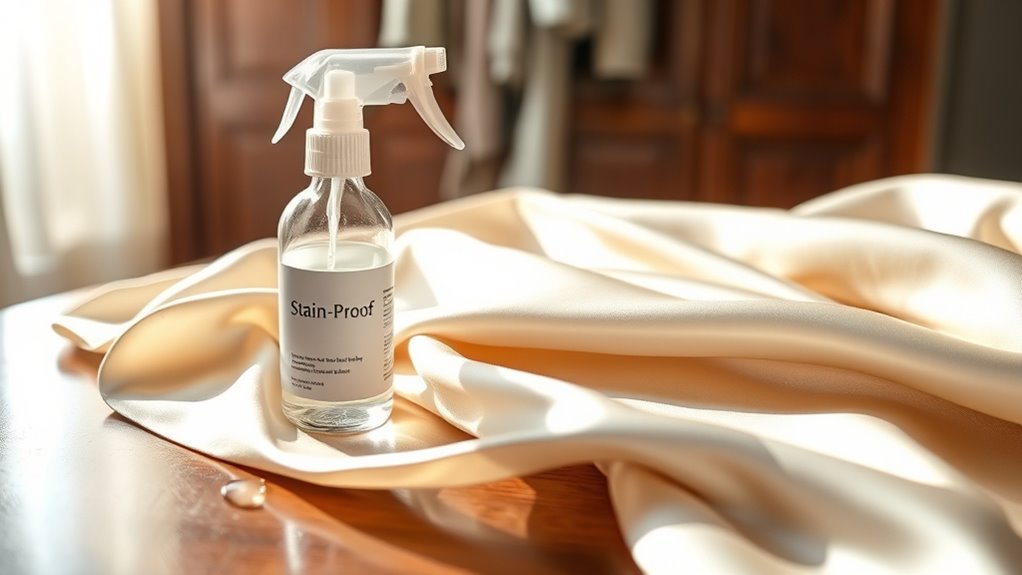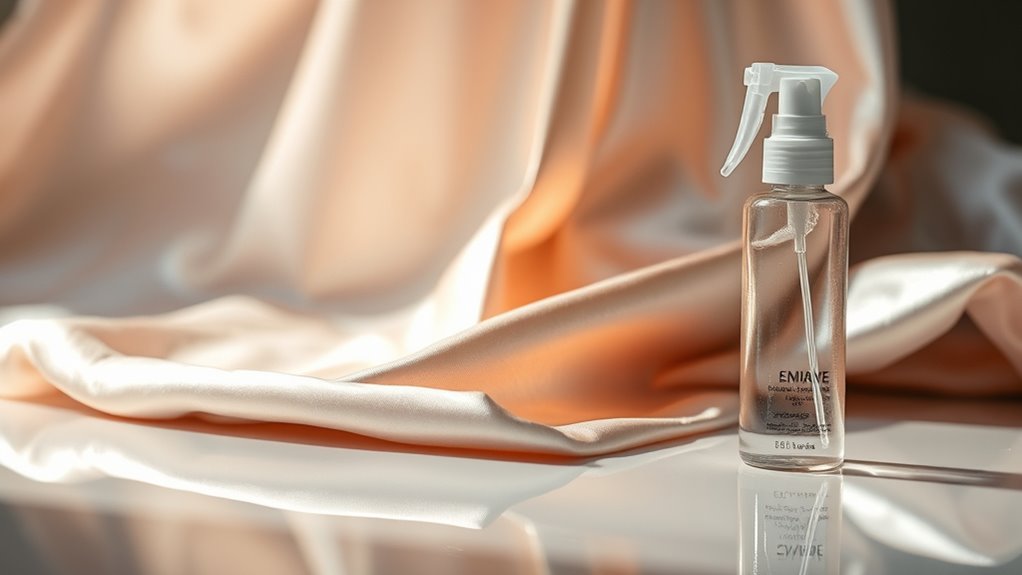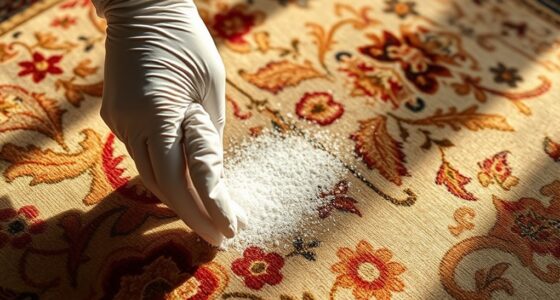Stain-proofing sprays can offer some protection for silk, but you need to choose formulations made specifically for delicate fabrics. Proper application is essential to avoid damage and ensure effective barrier formation. Keep in mind that no spray guarantees complete stain resistance, especially for oil or protein-based stains. If you continue, you’ll discover tips on selecting the right products and how to apply them safely on silk, helping you preserve its beauty longer.
Key Takeaways
- Properly formulated silk-safe stain-proofing sprays can create a protective barrier without damaging delicate fibers.
- Water-based, gentle sprays are typically safe for silk, maintaining its softness and appearance.
- Effectiveness depends on correct application, fabric condition, and choosing products labeled for silk or delicate fabrics.
- Overapplication or harsh chemicals may weaken silk fibers or cause discoloration.
- Regular reapplication and careful handling help maintain stain resistance on silk over time.
How Do Stain-Proofing Sprays Work?

Stain-proofing sprays work by creating a protective barrier on the surface of fabrics or materials, preventing liquids from penetrating and causing stains. When you apply the spray, it interacts with the fabric fiber, forming a thin, transparent coating that repels water and other liquids. This barrier reduces the chances of stain penetration, allowing spills to bead up instead of soaking in. The key is that the spray bonds to the fabric fiber at a microscopic level, which means it doesn’t alter the fabric’s feel or appearance. As a result, liquids stay on the surface longer, giving you more time to blot spills before they set. This process makes it easier to keep your textiles looking clean and fresh, even after accidental spills. Additionally, the effectiveness of stain-proofing sprays can depend on the type of fabric, with some materials being more receptive to treatment than others. For best results, proper surface preparation and application techniques are important to ensure the long-lasting protection of treated textiles. Regular reapplication may be necessary to maintain the durability of the barrier over time.
Types of Stain-Resistant Sprays Suitable for Fabrics

When choosing stain-resistant sprays for fabrics, you’ll notice options like water-based and solvent-based formulas, each with different benefits. Some sprays are specially designed to be safe on delicate materials like silk, while others focus on long-lasting protection. Understanding application methods and durability will help you pick the right product for your needs. Additionally, selecting products with advanced fraud detection techniques can ensure the safety and integrity of your transactions during purchase. For fabrics like silk, it’s also important to consider fabric-specific formulations that are gentle yet effective.
Water-Based vs. Solvent-Based Sprays
Choosing the right type of stain-resistant spray depends on your fabric and specific needs. Water-based sprays are generally gentler, allowing fabric breathability to stay intact, making them suitable for delicate materials. They tend to produce fewer chemical reactions that could damage fibers or alter textures. Solvent-based sprays, on the other hand, offer stronger stain protection and better water resistance but can compromise fabric breathability and may involve harsher chemicals. These are ideal for sturdier fabrics where breathability isn’t a primary concern. When selecting between them, consider your fabric’s sensitivity and how much you value breathability versus stain resistance. Always follow manufacturer instructions to avoid unwanted chemical reactions, especially with delicate fabrics like silk, and guarantee the spray aligns with your fabric’s needs. Additionally, understanding fabric composition can help determine the most appropriate spray type for your specific material.
Silk-Safe Fabric Protectants
Silk requires special care, so selecting the right stain-resistant spray is essential to protect its delicate fibers without causing damage. Silk-safe fabric protectants are formulated to be gentle enough for silk’s fine structure, often avoiding harsh chemicals that could interfere with silk dyeing or damage fabric embellishments. These protectants usually rely on water-based formulas that penetrate silk’s fibers without leaving a residue or dulling its natural sheen. When choosing a spray, check that it’s explicitly labeled for silk or delicate fabrics. Many silk-safe protectants also help preserve the vibrancy of silk dyeing and prevent stains from setting into intricate fabric embellishments. Additionally, using a vetted spray designed specifically for delicate textiles ensures that the fabric’s integrity and appearance remain intact. To further protect your silk, consider testing the spray on a small, inconspicuous area before full application. By using a suitable, silk-friendly spray, you can maintain the beauty and longevity of your silk garments.
Application and Durability
Are you selecting the right stain-resistant spray to guarantee your fabrics stay protected and last longer? Proper application is key to maximizing durability and stain resistance. Always follow the manufacturer’s instructions carefully, ensuring even coverage without oversaturating the fabric. For fabrics like silk, choose sprays specifically designed for delicate materials to prevent damage. Keep in mind that some sprays can affect fabric dyeing, so test a small, hidden area first. Regular reapplication may be necessary for ongoing stain removal and protection, especially in high-traffic areas. The best sprays form a durable barrier that withstands spills and cleaning, extending the life of your fabric. With proper application, stain-proofing sprays can provide long-lasting protection without compromising the fabric’s appearance or softness.
Compatibility of Stain-Proofing Sprays With Silk

Silk’s delicate nature makes it highly sensitive to many chemicals, so not all stain-proofing sprays are safe for it. You need to choose products specifically formulated for silk to avoid damage. When used correctly, these sprays can provide effective stain resistance without compromising the fabric’s integrity. Additionally, understanding the fabric’s chemical sensitivity can help prevent unintended harm from improper treatments. Proper application techniques are crucial to maintaining the silk’s appearance and softness. Furthermore, considering the proper testing procedures ensures that the treatment does not adversely affect the fabric. It is also helpful to consider the IRA investment strategy can help optimize overall financial planning, which is an important aspect of maintaining your lifestyle and protecting valuable textiles like silk.
Silk’s Chemical Sensitivity
Because of its delicate fiber structure, silk can be highly sensitive to many chemicals found in stain-proofing sprays. You need to be aware that chemical reactions between these sprays and silk fibers can cause discoloration, weakening, or even irreversible damage. Many chemicals in stain-proofing products are harsh and may interfere with textile preservation, leading to a loss of the fabric’s natural luster and softness. Silk’s sensitivity means that even small amounts of certain ingredients can compromise its integrity over time. To protect your silk items, always check labels for gentle, silk-safe formulas and avoid sprays with aggressive chemicals. Understanding silk’s chemical sensitivity helps you make informed choices, ensuring your delicate fabrics stay beautiful and intact longer. Additionally, being aware of fabric treatments and finishes can help prevent unintended damage from improper chemical exposure. Regularly inspecting your silk for signs of damage can help catch issues early before they become more severe. Moreover, consulting professional cleaning advice can provide tailored recommendations for maintaining silk’s beauty and durability.
Effective Stain Resistance
Choosing the right stain-proofing spray is essential for maintaining silk’s delicate qualities while providing effective stain resistance. When a spray is compatible with silk, it prevents stains from penetrating deeply, reducing stain absorption and making cleanup easier. However, sprays must also respect silk’s fabric dyeing properties to avoid discoloration or damage. A compatible treatment creates a barrier that repels liquids without altering the fabric’s appearance or texture. To help you decide, consider this table:
| Effectiveness | Fabric Compatibility | Emotional Impact |
|---|---|---|
| Prevents stains | Preserves dyeing | Peace of mind |
| Reduces absorption | Maintains softness | Confidence |
| Easy to clean | No discoloration | Satisfaction |
Additionally, selecting a stain-proofing spray that is fabric-safe ensures that the treatment will not compromise silk’s natural qualities. Properly choosing a stain-resistant treatment can significantly extend the lifespan of your silk garments. Understanding how fabric treatments work can help you make more informed decisions. Choose wisely to protect your silk while keeping its beauty intact.
Application Process for Safe Use on Silk Garments

To guarantee safe and effective stain-proofing on silk garments, you should start by thoroughly cleaning the fabric to remove any dirt or oils that could interfere with the spray’s adhesion. Ensure the silk is completely dry before applying the spray to preserve its fabric breathability. Hold the spray bottle about 6-8 inches from the surface and apply a light, even coat, avoiding oversaturation. Let the garment air dry fully, usually for several hours or as instructed. Be mindful that excessive spray can clog the fabric’s dye absorption abilities, potentially dulling its color or sheen. Always test the spray on a small, inconspicuous area first to check compatibility. Proper maintenance and care of the fabric can also help extend the effectiveness of the stain-proofing treatment. Additionally, understanding the fabric’s delicate nature can help prevent damage during application. Using appropriate application techniques ensures the spray penetrates evenly without harming the silk’s fibers. Being aware of the costs associated with special treatments can also aid in making informed decisions about fabric protection. Following these steps helps maintain silk’s delicate qualities while ensuring the spray works effectively.
Effectiveness of Stain-Proofing Sprays on Different Types of Stains

Stain-proofing sprays are generally effective against a variety of common spills, such as water-based stains, coffee, and wine. They create a protective barrier that helps prevent liquids from penetrating the fabric, maintaining fabric durability over time. However, their effectiveness varies depending on the stain type; oil-based or protein stains may require different treatments. When choosing a spray, consider its chemical safety, especially on delicate fabrics like silk, to avoid damage. A well-formulated spray will resist multiple stain types without compromising the fabric’s integrity. Keep in mind that no spray guarantees absolute protection, but proper application enhances fabric resilience and prolongs the garment’s lifespan while minimizing stain absorption. Additionally, knowing the horsepower of electric dirt bikes can help you understand their performance capabilities, much like assessing the effectiveness of stain-proofing on different fabrics. Understanding fabric treatment methods can further optimize stain resistance and fabric care.
Potential Risks and Downsides of Using Spray on Silk

While stain-proofing sprays can protect fabrics, applying them to silk carries certain risks. The chemicals in these sprays may cause unwanted chemical reactions with silk’s delicate fibers, potentially weakening or damaging the fabric over time. Additionally, some sprays contain volatile organic compounds (VOCs) that can emit fumes harmful to your health and the environment. The environmental impact of these chemicals is a concern, as they can seep into water sources during manufacturing or disposal. Silk’s natural fibers are sensitive, and improper application might lead to discoloration, loss of luster, or irreversible damage. Before using any spray, it’s essential to weigh these risks and consider how the chemical composition and potential environmental effects could compromise the fabric’s integrity and safety.
Alternative Methods to Protect Silk From Stains

Since chemical sprays can pose risks to delicate silk fibers and the environment, exploring alternative methods to protect your silk garments is wise. One effective approach is to keep stains at bay by controlling dye penetration. You can do this by pre-treating silk with a light fabric sealant designed for natural fibers or by applying a barrier wash that deposits a protective layer without compromising breathability. Additionally, choosing darker or patterned silk reduces the visibility of stains, minimizing the need for extensive protection. These methods help maintain fabric breathability, ensuring your silk remains soft and comfortable. Remember, gentle handling and prompt stain removal are also key to preserving your silk’s beauty and integrity over time.
Tips for Maintaining the Quality of Silk After Treatment

Maintaining the quality of silk after treatment requires careful handling and consistent care. Use gentle cleaning agents specifically designed for silk to prevent damage. Avoid harsh chemicals that can weaken fibers or remove fabric coatings. When storing silk, keep it in a cool, dry place away from direct sunlight. To emphasize the importance of proper care, consider this table:
| Tip | Action | Reason |
|---|---|---|
| Use gentle cleaning | Choose mild, silk-specific | Protects fabric coatings |
| Avoid harsh chemicals | Skip bleach and strong detergents | Prevents fiber damage |
| Store properly | Keep in breathable garment bags | Maintains silk integrity |
| Handle delicately | Support when moving or cleaning | Prevents tears or creases |
| Regular inspection | Check for signs of wear | Address issues early |
Following these tips ensures your silk remains vibrant and protected long-term.
Expert Recommendations for Stain Prevention and Care

Expert recommendations emphasize the importance of proactive stain prevention to keep your silk looking pristine. To address colorfastness concerns, always perform patch tests before applying any stain-proofing spray or treatment. This ensures the product won’t alter the fabric’s delicate sheen or cause color fading. Additionally, consider chemical sensitivity considerations; choose gentle, silk-specific products that don’t contain harsh solvents or dyes. Regularly vacuum or gently dust your silk to prevent dirt buildup, which can set stains later. When spills occur, act quickly with a soft blot—never rub—to minimize damage. Avoid direct contact with liquids or chemicals that could compromise the silk’s integrity. Following these guidelines helps preserve your silk’s beauty while reducing the risk of staining and damage over time.
Frequently Asked Questions
Can Stain-Proofing Sprays Damage the Natural Sheen of Silk?
You might wonder if stain-proofing sprays can harm silk’s natural sheen. When you apply a spray, it could alter the fabric texture if not designed for delicate materials like silk. Proper spray application is key; using a product specifically made for silk helps preserve its luster. Always test on a small, hidden area first to ensure the spray doesn’t damage or dull the silk’s beautiful natural sheen.
Are There Eco-Friendly Stain-Proofing Options Safe for Silk?
You’re looking for eco-friendly coatings that protect silk without harming it. Fortunately, natural fabric care options now include eco-friendly coatings made from plant-based ingredients, which are safe for delicate fabrics like silk. These solutions help repel stains while maintaining the fabric’s natural sheen and softness. Always check labels for eco credentials and test on a small area first to guarantee compatibility. This way, you protect your silk sustainably and effectively.
How Long Does a Stain-Proofing Treatment Typically Last on Silk?
You’ll want to know that the silk stain resistance from a spray typically lasts around 1 to 3 months, depending on usage and care. The spray’s longevity hinges on how often you wear or wash the silk, as frequent handling or cleaning can diminish its effectiveness. To maintain ideal protection, reapply the spray periodically, and handle your silk gently to preserve its stain-resistant qualities.
Is It Possible to Remove Stains From Silk After Using a Spray?
You can often remove stains from silk after using a spray, but it depends on the stain and spray type. Start with gentle stain removal methods and avoid harsh chemicals that can damage silk. Proper silk care involves acting quickly and testing any cleaning method on a small area first. While some stains may come out, persistent or set-in stains might require professional cleaning to preserve your silk garment.
Do Stain-Proofing Sprays Affect the Breathability of Silk Fabrics?
Imagine your silk fabric staying soft and breathable, even after applying a stain-proofing spray. While some worry about breathability loss, effective spray application techniques minimize this issue, preserving fabric durability. The spray forms a thin, flexible barrier, allowing air to pass through. So, you can protect your silk without sacrificing comfort or breathability, as long as you follow the manufacturer’s instructions carefully during application.
Conclusion
While stain-proofing sprays can help protect silk, they aren’t foolproof and might alter its delicate texture. If you’re worried about damaging your favorite piece, consider alternative methods like careful handling or professional treatments. Remember, a little extra caution goes a long way—silk’s beauty is worth the effort. So, if you follow the right steps, you can keep your silk looking stunning without sacrificing its elegance or risking unnecessary damage.









